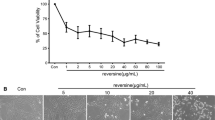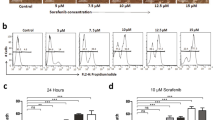Abstract
Hepatic stellate cell (HSC) activation plays an indispensable role in hepatic fibrosis. Inducing apoptosis of activated HSCs can attenuate or reverse fibrogenesis. In this study, we initially found that oroxylin A (OA) protected CCl4-induced liver injury accompanied by endoplasmic reticulum stress (ERS) activation of HSCs in mice. In vitro, OA treatment markedly reduced fibrogenesis by modulating extracellular matrix synthesis and degradation. OA inhibited cell proliferation and induced cell cycle arrest of HSCs at S phase. Further, OA was observed to induce HSC apoptosis, as indicated by caspase activation. Using the eIF2α dephosphorylation inhibitor salubrinal, we found that ERS pathway activation was required for OA to induce HSC apoptosis. ERS-related proteins were significantly upregulated by OA treatment, and salubrinal abrogated the effects of OA on HSCs. Thus, we inferred that OA attenuated HSC activation by promoting ERS. In vivo, inhibition of ERS by salubrinal partly abrogated the hepatoprotective effect of OA in CCl4-treated mice. In conclusion, our findings suggest a role for ERS in the mechanism underlying amelioration of hepatic fibrosis by OA.








Similar content being viewed by others
References
Kisseleva T, Brenner DA (2006) Hepatic stellate cells and the reversal of fibrosis. J Gastroenterol Hepatol 21(Suppl 3):S84–S87. https://doi.org/10.1111/j.1440-1746.2006.04584.x
Lee UE, Friedman SL (2011) Mechanisms of hepatic fibrogenesis. Best Pract Res Clin Gastroenterol 25(2):195–206. https://doi.org/10.1016/j.bpg.2011.02.005
Pradere JP, Kluwe J, De Minicis S, Jiao JJ, Gwak GY, Dapito DH, Jang MK, Guenther ND, Mederacke I, Friedman R, Dragomir AC, Aloman C, Schwabe RF (2013) Hepatic macrophages but not dendritic cells contribute to liver fibrosis by promoting the survival of activated hepatic stellate cells in mice. Hepatology 58(4):1461–1473. https://doi.org/10.1002/hep.26429
Roderburg C, Luedde M, Vargas Cardenas D, Vucur M, Mollnow T, Zimmermann HW, Koch A, Hellerbrand C, Weiskirchen R, Frey N, Tacke F, Trautwein C, Luedde T (2013) miR-133a mediates TGF-beta-dependent derepression of collagen synthesis in hepatic stellate cells during liver fibrosis. J Hepatol 58(4):736–742. https://doi.org/10.1016/j.jhep.2012.11.022
Novo E, Marra F, Zamara E, Valfre di Bonzo L, Monitillo L, Cannito S, Petrai I, Mazzocca A, Bonacchi A, De Franco RS, Colombatto S, Autelli R, Pinzani M, Parola M (2006) Overexpression of Bcl-2 by activated human hepatic stellate cells: resistance to apoptosis as a mechanism of progressive hepatic fibrogenesis in humans. Gut 55(8):1174–1182. https://doi.org/10.1136/gut.2005.082701
Bian M, Chen X, Zhang C, Jin H, Wang F, Shao J, Chen A, Zhang F, Zheng S (2017) Magnesium isoglycyrrhizinate promotes the activated hepatic stellate cells apoptosis via endoplasmic reticulum stress and ameliorates fibrogenesis in vitro and in vivo. Biofactors 43(6):836–846. https://doi.org/10.1002/biof.1390
Hotamisligil GS (2010) Endoplasmic reticulum stress and the inflammatory basis of metabolic disease. Cell 140(6):900–917. https://doi.org/10.1016/j.cell.2010.02.034
Jalan R, De Chiara F, Balasubramaniyan V, Andreola F, Khetan V, Malago M, Pinzani M, Mookerjee RP, Rombouts K (2016) Ammonia produces pathological changes in human hepatic stellate cells and is a target for therapy of portal hypertension. J Hepatol 64(4):823–833. https://doi.org/10.1016/j.jhep.2015.11.019
Lu L, Guo Q, Zhao L (2016) Overview of Oroxylin A: a promising flavonoid compound. Phytother Res 30(11):1765–1774. https://doi.org/10.1002/ptr.5694
Li HB, Chen F (2005) Isolation and purification of baicalein, wogonin and oroxylin A from the medicinal plant Scutellaria baicalensis by high-speed counter-current chromatography. J Chromatogr A 1074(1–2):107–110
Xu W, Lu C, Zhang F, Shao J, Yao S, Zheng S (2017) Dihydroartemisinin counteracts fibrotic portal hypertension via farnesoid X receptor-dependent inhibition of hepatic stellate cell contraction. FEBS J 284(1):114–133. https://doi.org/10.1111/febs.13956
Zhang F, Zhang Z, Chen L, Kong D, Zhang X, Lu C, Lu Y, Zheng S (2014) Curcumin attenuates angiogenesis in liver fibrosis and inhibits angiogenic properties of hepatic stellate cells. J Cell Mol Med 18(7):1392–1406. https://doi.org/10.1111/jcmm.12286
Chen Q, Chen L, Wu X, Zhang F, Jin H, Lu C, Shao J, Kong D, Wu L, Zheng S (2016) Dihydroartemisinin prevents liver fibrosis in bile duct ligated rats by inducing hepatic stellate cell apoptosis through modulating the PI3K/Akt pathway. IUBMB Life 68(3):220–231. https://doi.org/10.1002/iub.1478
Abriss B, Hollweg G, Gressner AM, Weiskirchen R (2003) Adenoviral-mediated transfer of p53 or retinoblastoma protein blocks cell proliferation and induces apoptosis in culture-activated hepatic stellate cells. J Hepatol 38(2):169–178
Bai T, Lian LH, Wu YL, Wan Y, Nan JX (2013) Thymoquinone attenuates liver fibrosis via PI3K and TLR4 signaling pathways in activated hepatic stellate cells. Int Immunopharmacol 15(2):275–281. https://doi.org/10.1016/j.intimp.2012.12.020
Zhang Z, Guo M, Zhao S, Shao J, Zheng S (2016) ROS-JNK1/2-dependent activation of autophagy is required for the induction of anti-inflammatory effect of dihydroartemisinin in liver fibrosis. Free Radic Biol Med 101:272–283. https://doi.org/10.1016/j.freeradbiomed.2016.10.498
Berger C, Kannan R, Myneni S, Renner S, Shashidhara LS, Technau GM (2010) Cell cycle independent role of Cyclin E during neural cell fate specification in Drosophila is mediated by its regulation of Prospero function. Dev Biol 337(2):415–424. https://doi.org/10.1016/j.ydbio.2009.11.012
Mazumder S, Plesca D, Almasan A (2007) A jekyll and hyde role of cyclin E in the genotoxic stress response: switching from cell cycle control to apoptosis regulation. Cell Cycle 6(12):1437–1442
Gao C, Pang M, Zhou Z, Long S, Dong D, Yang J, Cao M, Zhang C, Han S, Li L (2015) Epidermal growth factor receptor-coamplified and overexpressed protein (VOPP1) is a putative oncogene in gastric cancer. Clin Exp Med 15(4):469–475. https://doi.org/10.1007/s10238-014-0320-7
Hengartner MO (2000) The biochemistry of apoptosis. Nature 407(6805):770–776. https://doi.org/10.1038/35037710
Zhou F, Yang Y, Xing D (2011) Bcl-2 and Bcl-xL play important roles in the crosstalk between autophagy and apoptosis. FEBS J 278(3):403–413. https://doi.org/10.1111/j.1742-4658.2010.07965.x
Zhang T, Zhao G, Zhu X, Jiang K, Wu H, Deng G, Qiu C (2019) Sodium selenite induces apoptosis via ROS-mediated NF-kappaB signaling and activation of the Bax-caspase-9-caspase-3 axis in 4T1 cells. J Cell Physiol 234(3):2511–2522. https://doi.org/10.1002/jcp.26783
Bruni E, Reichle A, Scimeca M, Bonanno E, Ghibelli L (2018) Lowering etoposide doses shifts cell demise from caspase-dependent to differentiation and caspase-3-independent apoptosis via DNA damage response, inducing AML culture extinction. Front Pharmacol 9:1307. https://doi.org/10.3389/fphar.2018.01307
Engert F, Schneider C, Weibeta LM, Probst M, Fulda S (2015) PARP inhibitors sensitize ewing sarcoma cells to temozolomide-induced apoptosis via the mitochondrial pathway. Mol Cancer Ther 14(12):2818–2830. https://doi.org/10.1158/1535-7163.MCT-15-0587
Monson T, Wright T, Galan HL, Reynolds PR, Arroyo JA (2017) Caspase dependent and independent mechanisms of apoptosis across gestation in a sheep model of placental insufficiency and intrauterine growth restriction. Apoptosis 22(5):710–718. https://doi.org/10.1007/s10495-017-1343-9
Yu Y, Xie Z, Wang J, Chen C, Du S, Chen P, Li B, Jin T, Zhao H (2016) Single-nucleotide polymorphisms of MMP2 in MMP/TIMP pathways associated with the risk of alcohol-induced osteonecrosis of the femoral head in Chinese males: A case-control study. Medicine 95(49):e5407. https://doi.org/10.1097/MD.0000000000005407
Peres RC, Line SR (2005) Analysis of MMP-9 and TIMP-2 gene promoter polymorphisms in individuals with hypodontia. Braz Dent J 16(3):231–236
Liu Q, Zhang X, Hu X, Dai L, Fu X, Zhang J, Ao Y (2016) Circular RNA related to the chondrocyte ECM regulates MMP13 expression by functioning as a MiR-136 'Sponge' in human cartilage degradation. Sci Rep 6:22572. https://doi.org/10.1038/srep22572
Tao YK, Yu PL, Bai YP, Yan ST, Zhao SP, Zhang GQ (2016) Role of PERK/eIF2alpha/CHOP endoplasmic reticulum stress pathway in oxidized low-density lipoprotein mediated induction of endothelial apoptosis. Biomed Environ Sci 29(12):868–876. https://doi.org/10.3967/bes2016.116
Ridler C (2017) Alzheimer disease: inhibition of IRE1 signalling reduces AD pathology. Nat Rev Neurol 13(5):258. https://doi.org/10.1038/nrneurol.2017.51
Lai WL, Wong NS (2008) The PERK/eIF2 alpha signaling pathway of unfolded protein response is essential for N-(4-hydroxyphenyl)retinamide (4HPR)-induced cytotoxicity in cancer cells. Exp Cell Res 314(8):1667–1682. https://doi.org/10.1016/j.yexcr.2008.02.002
Masouminia M, Samadzadeh S, Ebaee A, French BA, Tillman B, French SW (2016) Alcoholic steatohepatitis (ASH) causes more UPR-ER stress than non-alcoholic steatohepatitis (NASH). Exp Mol Pathol 101(2):201–206. https://doi.org/10.1016/j.yexmp.2016.08.002
Rani S, Sreenivasaiah PK, Cho C, Kim DH (2017) Salubrinal alleviates pressure overload-induced cardiac hypertrophy by inhibiting endoplasmic reticulum stress pathway. Mol Cells 40(1):66–72. https://doi.org/10.14348/molcells.2017.2259
Gong T, Wang Q, Lin Z, Chen ML, Sun GZ (2012) Endoplasmic reticulum (ER) stress inhibitor salubrinal protects against ceramide-induced SH-SY5Y cell death. Biochem Biophys Res Commun 427(3):461–465. https://doi.org/10.1016/j.bbrc.2012.08.068
McKimpson WM, Kitsis RN (2017) A new role for the ER unfolded protein response mediator ATF6: induction of a generalized antioxidant program. Circ Res 120(5):759–761. https://doi.org/10.1161/CIRCRESAHA.117.310577
Yin L, Dai Y, Cui Z, Jiang X, Liu W, Han F, Lin A, Cao J, Liu J (2017) The regulation of cellular apoptosis by the ROS-triggered PERK/EIF2alpha/chop pathway plays a vital role in bisphenol A-induced male reproductive toxicity. Toxicol Appl Pharmacol 314:98–108. https://doi.org/10.1016/j.taap.2016.11.013
Furuhashi H, Tomita K, Teratani T, Shimizu M, Nishikawa M, Higashiyama M, Takajo T, Shirakabe K, Maruta K, Okada Y, Kurihara C, Watanabe C, Komoto S, Aosasa S, Nagao S, Yamamoto J, Miura S, Hokari R (2018) Vitamin A-coupled liposome system targeting free cholesterol accumulation in hepatic stellate cells offers a beneficial therapeutic strategy for liver fibrosis. Hepatol Res 48(5):397–407. https://doi.org/10.1111/hepr.13040
Higashi T, Friedman SL, Hoshida Y (2017) Hepatic stellate cells as key target in liver fibrosis. Adv Drug Deliv Rev 121:27–42. https://doi.org/10.1016/j.addr.2017.05.007
Li Y, Zheng GY, Liu Y (2016) Salubrinal protects human lens epithelial cells against endoplasmic reticulum stress-associated apoptosis. Zhonghua Yan Ke Za Zhi 52(6):437–443. https://doi.org/10.3760/cma.j.issn.0412-4081.2016.06.008
Zhang Z, Wei C, Zhou Y, Yan T, Wang Z, Li W, Zhao L (2017) Homocysteine induces apoptosis of human umbilical vein endothelial cells via mitochondrial dysfunction and endoplasmic reticulum stress. Oxid Med Cell Longev.https://doi.org/10.1155/2017/5736506
Acknowledgements
This work was supported by the National Natural Science Foundation of China (81270514, 31401210, 31571455), Science and Technology Plan Program of Fujian Province (2017Y0061), Scientific Research Foundation of Third Institute of Oceanography, the Ministry of Natural Resources (2018020),Youth Natural Science Foundation of Jiangsu Province (BK20140955), Priority Academic Program Development of Jiangsu Higher Education Institutions, 2013 Program for Excellent Scientific and Technological Innovation Team of Jiangsu Higher Education, Natural Science Research General Program of Jiangsu Higher Education Institutions (14KJB310011), Top-notch Academic Programs Project of Jiangsu Higher Education Institutions (TAPPPPZY2015A070), and Open Project Program of Jiangsu Key Laboratory for Pharmacology and Safety Evaluation of Chinese Materia Medica (JKLPSE201502).
Author information
Authors and Affiliations
Corresponding authors
Ethics declarations
Conflict of interest
The authors declare that they have no conflicts of interest.
Additional information
Publisher's Note
Springer Nature remains neutral with regard to jurisdictional claims in published maps and institutional affiliations.
Electronic supplementary material
Below is the link to the electronic supplementary material.
Rights and permissions
About this article
Cite this article
Bian, M., He, J., Jin, H. et al. Oroxylin A induces apoptosis of activated hepatic stellate cells through endoplasmic reticulum stress. Apoptosis 24, 905–920 (2019). https://doi.org/10.1007/s10495-019-01568-2
Published:
Issue Date:
DOI: https://doi.org/10.1007/s10495-019-01568-2




